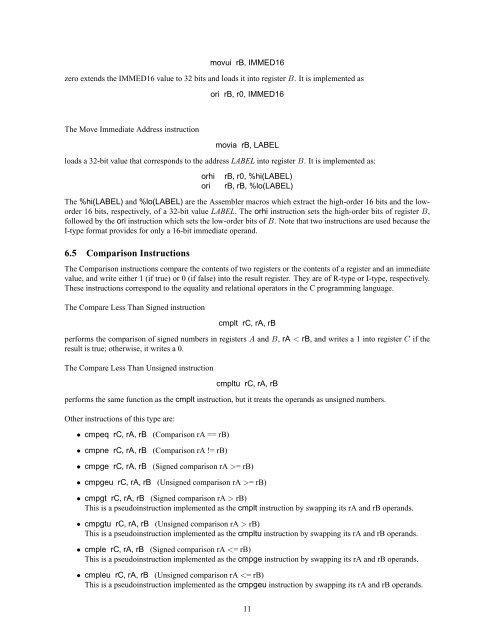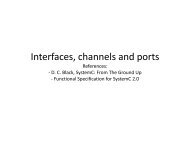Introduction to the Altera Nios II Soft Processor - FTP - Altera
Introduction to the Altera Nios II Soft Processor - FTP - Altera
Introduction to the Altera Nios II Soft Processor - FTP - Altera
You also want an ePaper? Increase the reach of your titles
YUMPU automatically turns print PDFs into web optimized ePapers that Google loves.
movui rB, IMMED16<br />
zero extends <strong>the</strong> IMMED16 value <strong>to</strong> 32 bits and loads it in<strong>to</strong> register B. It is implemented as<br />
ori rB, r0, IMMED16<br />
The Move Immediate Address instruction<br />
movia rB, LABEL<br />
loads a 32-bit value that corresponds <strong>to</strong> <strong>the</strong> address LABEL in<strong>to</strong> register B. It is implemented as:<br />
orhi<br />
ori<br />
rB, r0, %hi(LABEL)<br />
rB, rB, %lo(LABEL)<br />
The %hi(LABEL) and %lo(LABEL) are <strong>the</strong> Assembler macros which extract <strong>the</strong> high-order 16 bits and <strong>the</strong> loworder<br />
16 bits, respectively, of a 32-bit value LABEL. The orhi instruction sets <strong>the</strong> high-order bits of register B,<br />
followed by <strong>the</strong> ori instruction which sets <strong>the</strong> low-order bits of B. Note that two instructions are used because <strong>the</strong><br />
I-type format provides for only a 16-bit immediate operand.<br />
6.5 Comparison Instructions<br />
The Comparison instructions compare <strong>the</strong> contents of two registers or <strong>the</strong> contents of a register and an immediate<br />
value, and write ei<strong>the</strong>r 1 (if true) or 0 (if false) in<strong>to</strong> <strong>the</strong> result register. They are of R-type or I-type, respectively.<br />
These instructions correspond <strong>to</strong> <strong>the</strong> equality and relational opera<strong>to</strong>rs in <strong>the</strong> C programming language.<br />
The Compare Less Than Signed instruction<br />
cmplt rC, rA, rB<br />
performs <strong>the</strong> comparison of signed numbers in registers A and B, rA < rB, and writes a 1 in<strong>to</strong> register C if <strong>the</strong><br />
result is true; o<strong>the</strong>rwise, it writes a 0.<br />
The Compare Less Than Unsigned instruction<br />
cmpltu rC, rA, rB<br />
performs <strong>the</strong> same function as <strong>the</strong> cmplt instruction, but it treats <strong>the</strong> operands as unsigned numbers.<br />
O<strong>the</strong>r instructions of this type are:<br />
• cmpeq rC, rA, rB<br />
• cmpne rC, rA, rB<br />
• cmpge rC, rA, rB<br />
(Comparison rA == rB)<br />
(Comparison rA != rB)<br />
(Signed comparison rA >= rB)<br />
• cmpgeu rC, rA, rB (Unsigned comparison rA >= rB)<br />
• cmpgt rC, rA, rB (Signed comparison rA > rB)<br />
This is a pseudoinstruction implemented as <strong>the</strong> cmplt instruction by swapping its rA and rB operands.<br />
• cmpgtu rC, rA, rB (Unsigned comparison rA > rB)<br />
This is a pseudoinstruction implemented as <strong>the</strong> cmpltu instruction by swapping its rA and rB operands.<br />
• cmple rC, rA, rB (Signed comparison rA

















